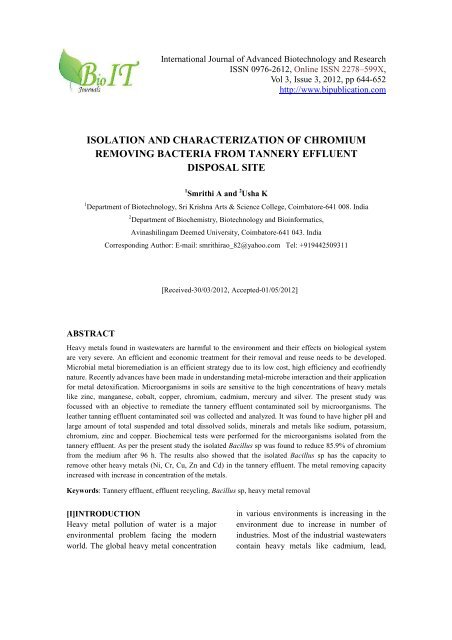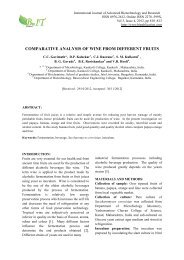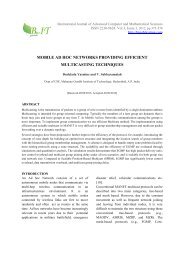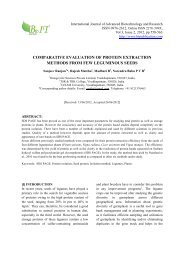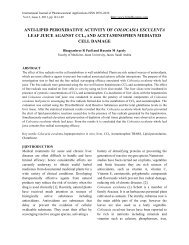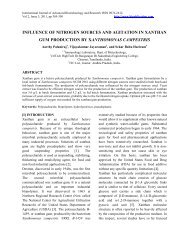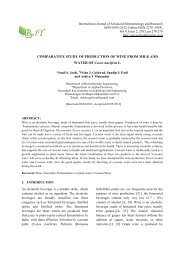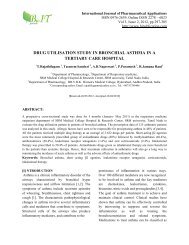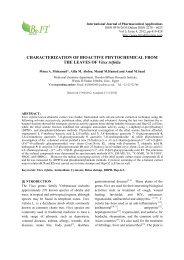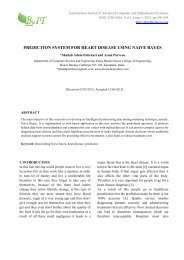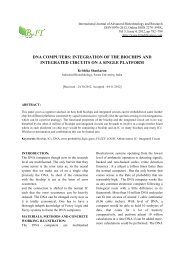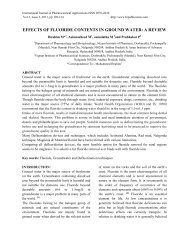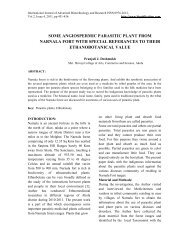isolation and characterization of chromium removing bacteria from ...
isolation and characterization of chromium removing bacteria from ...
isolation and characterization of chromium removing bacteria from ...
Create successful ePaper yourself
Turn your PDF publications into a flip-book with our unique Google optimized e-Paper software.
International Journal <strong>of</strong> Advanced Biotechnology <strong>and</strong> ResearchISSN 0976-2612, Online ISSN 2278–599X,Vol 3, Issue 3, 2012, pp 644-652http://www.bipublication.comISOLATION AND CHARACTERIZATION OF CHROMIUMREMOVING BACTERIA FROM TANNERY EFFLUENTDISPOSAL SITE1 Smrithi A <strong>and</strong> 2 Usha K1 Department <strong>of</strong> Biotechnology, Sri Krishna Arts & Science College, Coimbatore-641 008. India2 Department <strong>of</strong> Biochemistry, Biotechnology <strong>and</strong> Bioinformatics,Avinashilingam Deemed University, Coimbatore-641 043. IndiaCorresponding Author: E-mail: smrithirao_82@yahoo.com Tel: +919442509311[Received-30/03/2012, Accepted-01/05/2012]ABSTRACTHeavy metals found in wastewaters are harmful to the environment <strong>and</strong> their effects on biological systemare very severe. An efficient <strong>and</strong> economic treatment for their removal <strong>and</strong> reuse needs to be developed.Microbial metal bioremediation is an efficient strategy due to its low cost, high efficiency <strong>and</strong> ec<strong>of</strong>riendlynature. Recently advances have been made in underst<strong>and</strong>ing metal-microbe interaction <strong>and</strong> their applicationfor metal detoxification. Microorganisms in soils are sensitive to the high concentrations <strong>of</strong> heavy metalslike zinc, manganese, cobalt, copper, <strong>chromium</strong>, cadmium, mercury <strong>and</strong> silver. The present study wasfocussed with an objective to remediate the tannery effluent contaminated soil by microorganisms. Theleather tanning effluent contaminated soil was collected <strong>and</strong> analyzed. It was found to have higher pH <strong>and</strong>large amount <strong>of</strong> total suspended <strong>and</strong> total dissolved solids, minerals <strong>and</strong> metals like sodium, potassium,<strong>chromium</strong>, zinc <strong>and</strong> copper. Biochemical tests were performed for the microorganisms isolated <strong>from</strong> thetannery effluent. As per the present study the isolated Bacillus sp was found to reduce 85.9% <strong>of</strong> <strong>chromium</strong><strong>from</strong> the medium after 96 h. The results also showed that the isolated Bacillus sp has the capacity toremove other heavy metals (Ni, Cr, Cu, Zn <strong>and</strong> Cd) in the tannery effluent. The metal <strong>removing</strong> capacityincreased with increase in concentration <strong>of</strong> the metals.Keywords: Tannery effluent, effluent recycling, Bacillus sp, heavy metal removal[I]INTRODUCTIONHeavy metal pollution <strong>of</strong> water is a majorenvironmental problem facing the modernworld. The global heavy metal concentrationin various environments is increasing in theenvironment due to increase in number <strong>of</strong>industries. Most <strong>of</strong> the industrial wastewaterscontain heavy metals like cadmium, lead,
ISOLATION AND CHARACTERIZATION OF CHROMIUM REMOVING BACTERIAzinc, cobalt <strong>and</strong> <strong>chromium</strong>. Among heavymetals <strong>chromium</strong> is the major pollutant <strong>of</strong> theleather tanning industry <strong>and</strong> is toxic to plants<strong>and</strong> animals around the environment [9].The damage to the environment by thehazardous tannery effluent is becoming anacute problem in several countries. Thechrome tanning process results in toxicmetals, especially <strong>chromium</strong> III passing towaste water <strong>and</strong> are not easily eliminated byordinary treatment process [13]. Tannerywaste waters are mainly characterized byhigh salinity, high organic loading <strong>and</strong>specific pollutants such as <strong>chromium</strong> [10].The industrial effluent released directly orindirectly into natural water resources, mostlywithout proper treatment, poses a majorthreat to the environment.Among the different forms <strong>of</strong> <strong>chromium</strong>, thehexavalent <strong>chromium</strong> Cr 6+ is the most toxic<strong>and</strong> carcinogenic due to its high solubility inwater, rapid permeability through biologicalmembranes <strong>and</strong> subsequent interaction withintracellular proteins <strong>and</strong> nucleic acids. Theheavy metals in general cannot bebiologically transformed to more or less toxicproducts <strong>and</strong> hence persist in the environmentindefinitely [35]. They are significantly toxiceven in small amounts <strong>and</strong> can cause diseasesin humans <strong>and</strong> animals as they causeirreversible changes in the body, especially inthe Central Nervous System [26]. Soilcontamination by heavy metals is <strong>of</strong>tenirreversible <strong>and</strong> may repress or even kill parts<strong>of</strong> the microbial community <strong>and</strong> it isgenerally assumed that the exposure to metalsleads to the establishment <strong>of</strong> a tolerant/resistant microbial population [32].Microorganisms play a significant <strong>and</strong> vitalrole in bioremediation <strong>of</strong> heavy metalcontaminated soil <strong>and</strong> wastewater.Indigenous soil microbes appear well suitedfor Chromium (VI) transformation in highlycontaminated soil <strong>and</strong> may accumulate<strong>chromium</strong> within its cells by adaptation to thehigh concentration <strong>of</strong> the metal. Very stablefinal <strong>chromium</strong> forms can be achieved as aresult <strong>of</strong> microbial activity, with minimal risk<strong>of</strong> re-release <strong>of</strong> Cr (VI) [22]. In this paper aneffort has been made to remove heavy metals<strong>from</strong> tannery effluent using microorganisms.[II] MATERIALS AND METHODS2.1 Tannery EffluentThe effluent was collected <strong>from</strong> a selectedleather processing industry situated atDindigul in Tamil Nadu, India at weeklyintervals for five weeks, pooled together <strong>and</strong>stored at 4 °C for analysis. The collectedtannery effluent was analyzed forphysicochemical properties like colour,odour, turbidity, pH, total suspended solids,total dissolved salts, chemical oxygendem<strong>and</strong> (COD), biological oxygen dem<strong>and</strong>(BOD) [1], carbonate, bicarbonate, sodium,potassium [20], <strong>chromium</strong>, copper,cadmium, nickel <strong>and</strong> zinc [1].2.2 Isolation <strong>of</strong> the microorganism <strong>from</strong>tannery effluent contaminated soilFor <strong>isolation</strong> <strong>of</strong> <strong>chromium</strong> resistant <strong>bacteria</strong>,1.0 g effluent treated soil sample wasdispersed in 100 mL <strong>of</strong> the sterile distilledwater. A serial dilution was made up to 10 -5<strong>from</strong> the effluent treated soil sample. 100 µL<strong>of</strong> each dilution was spread on to nutrientplates containing 10 µg potassiumdichromate (K 2 Cr 2 O 7 ) per mL <strong>of</strong> themedium. The growth <strong>of</strong> the <strong>bacteria</strong>l colonieswas observed after 24 h <strong>of</strong> incubation at 37°C. It was subcultured on nutrient agar platecontaining 10 µg <strong>of</strong> potassium dichromate(K 2 Cr 2 O 7 ) per mL. Biochemical tests likeGram staining [27], dextrose fermentation,sucrose fermentation, IMViC, catalaseactivity, starch hydrolysis [11] <strong>and</strong> gelatinSmrithi A <strong>and</strong> Usha K 645
ISOLATION AND CHARACTERIZATION OF CHROMIUM REMOVING BACTERIAliquefaction [15] were carried out to identifythe isolated microorganisms.2.3 Optimum growth conditionsFor the determination <strong>of</strong> optimumtemperature for the growth <strong>of</strong> the isolated<strong>bacteria</strong>, test tubes containing 5 mL nutrientbroth were taken in four sets, autoclaved <strong>and</strong>inoculated with 20 µL <strong>of</strong> freshly preparedculture <strong>of</strong> the isolate. The four sets <strong>of</strong> tubeswere incubated each at 25, 30, 37, 45 °Crespectively. After an incubation period <strong>of</strong> 12hours, the absorbance was measured at 600nm. For the determination <strong>of</strong> optimum pH,test tubes having 5 mL nutrient broth weretaken in 9 test tubes <strong>and</strong> then, the pH wasadjusted to 5.0, 5.5, 6.0, 6.5, 7.0, 7.5, 8.0,8.5, <strong>and</strong> 9.0. The test tubes were inoculatedwith 20 µL <strong>of</strong> freshly prepared culture <strong>of</strong> theisolate. After 12 hours <strong>of</strong> incubation, theabsorbance was measured at 600 nm.2.4 Growth rate <strong>of</strong> <strong>bacteria</strong>l isolates with<strong>and</strong> without <strong>chromium</strong>Growth curves <strong>of</strong> <strong>bacteria</strong>l isolates weredetermined with 10 µg K 2 Cr 2 O 7 per mL <strong>and</strong>without K 2 Cr 2 O 7 (control). For <strong>bacteria</strong>lisolates, 50 mL nutrient broth was taken inone set consisting <strong>of</strong> three flasks, autoclaved<strong>and</strong> then inoculated with 20 µL <strong>of</strong> the freshlyprepared inoculum. These cultures wereincubated at 37 °C in a shaker at 30 rpm. Theabsorbance <strong>of</strong> the cultures was measured at600 nm at intervals <strong>of</strong> 2 h up to 24 h afterinoculation.2.5 Removal <strong>of</strong> <strong>chromium</strong> by <strong>bacteria</strong>lisolatesIn order to determine the ability <strong>of</strong> <strong>bacteria</strong>lisolate to reduce Cr 6+ to Cr 3+ ,spectrophotometric method was used. 5 mLsamples were taken <strong>from</strong> the culture after 24h, spun down at 10,000 rpm for 5 min <strong>and</strong>the supernatant was used for the estimation<strong>of</strong> <strong>chromium</strong> left in the medium. From this1.0 mL sample was taken <strong>and</strong> diluted with 9mL <strong>of</strong> distilled water in the test tubes. Themixture was kept at room temperature for 10min <strong>and</strong> OD was taken at 600 nm.2.6 Removal <strong>of</strong> heavy metals by isolatedbacterium20 mL <strong>of</strong> the sterile medium containingnutrient agar 15 g, K 2 HPO 4 0.5 g, K 2 PO 4 1.5g, glucose 0.05 g <strong>and</strong> distilled water to 1000mL was poured into sterile petriplates <strong>and</strong>was allowed to solidify. Then each isolatedmicroorganism was swabbed on the medium.Four wells were made on each petriplateusing well puncture. Different concentrations(0.5, 1.0, 1.5 <strong>and</strong> 2 mg/mL) <strong>of</strong> metals (Cu,Cd, Cr, Ni, <strong>and</strong> Zn) were made <strong>and</strong> loaded onthe wells. Then the plates were incubated for24 h at 37 °C[3] RESULTS3.1 Tannery EffluentThe collected leather tanning industrialeffluent was assessed for its physicochemicalproperties <strong>and</strong> toxic metal levels (Table 1).The effluent sample analyzed had a pH value<strong>of</strong> 10.5. The total suspended solids (2300mg/L) <strong>and</strong> total dissolved salts (12,900 mg/L)in the effluent sample were found to be veryhigh when compared to BIS st<strong>and</strong>ards. COD<strong>and</strong> BOD in the selected effluent samplewere found to be 3180 mg/L <strong>and</strong> 1300 mg/Lrespectively.In the effluent sample analyzed, the presence<strong>of</strong> carbonates <strong>and</strong> bicarbonates were found tobe very high, 7250 mg/L <strong>and</strong> 10,238 mg/Lrespectively. Chromium is the widely usedheavy metal in tannery industries <strong>and</strong> wasfound to be 179 mg/L in the effluent. Othermetals like cadmium, <strong>chromium</strong>, copper,nickel <strong>and</strong> zinc were present at levels <strong>of</strong> 4.81,179, 64.32l, 132, <strong>and</strong> 171 mg/L respectively(Table 2).Smrithi A <strong>and</strong> Usha K 646
ISOLATION AND CHARACTERIZATION OF CHROMIUM REMOVING BACTERIA3.2 Isolation <strong>of</strong> micoorganisms <strong>from</strong> theeffluent contaminated soilThe <strong>chromium</strong> resistant <strong>bacteria</strong> wereisolated <strong>from</strong> the effluent treated soil byserial dilution method, each isolated colonieswere picked up <strong>and</strong> were sub-cultured. Thebiochemical <strong>characterization</strong>s were carriedout to identify the microorganisms. Cr (VI)resistant <strong>bacteria</strong> were isolated on the basis <strong>of</strong>growth in Cr (VI) enriched medium [7]. Allthe soil samples yielded a large number <strong>of</strong>colony-forming units/mL (cfu/mL). Theserial dilution method indicated the differentcolonies in dilution <strong>of</strong> 10 -5 were found to beGram positive <strong>bacteria</strong> <strong>and</strong> gave positiveresult for catalase, starch hydrolysis <strong>and</strong>gelatine liquefaction tests <strong>and</strong> negative resultfor IMViC test indicating it to be Bacillus sp.3.3 Optimum growth characteristics <strong>of</strong><strong>chromium</strong> resistant <strong>bacteria</strong>In the present study, the optimumtemperature for <strong>chromium</strong> resistant <strong>bacteria</strong>Bacillus sp, was found to be 37°C (Figure 1).The <strong>chromium</strong> resistant <strong>bacteria</strong>, Bacillus sp,showed maximum growth at pH 7 (Figure 2).The growth curve <strong>of</strong> isolated microorganismin the presence <strong>of</strong> <strong>chromium</strong> (K 2 Cr 2 O 7 ) 10µg/mL was compared with the control (i.e nometal ions were added). There was nosignificant difference between control <strong>and</strong><strong>chromium</strong> treated culture (Figure 3). But thegrowth <strong>of</strong> the isolate was decreased in after18 hours in presence <strong>of</strong> <strong>chromium</strong>.3.4 Tannery effluent contaminated soilBoth the control <strong>and</strong> effluent contaminatedsoil samples were analysed for essentialparameters (Table 2) <strong>and</strong> it is evident that theeffluent contaminated soil has a greateramount <strong>of</strong> mineral <strong>and</strong> metal content than thecontrol soil. Chromium reducing capability <strong>of</strong><strong>bacteria</strong>l isolate was analysed by addingPotassium dichromate (K 2 Cr 2 O 7 ) at 10 µg/mLin the culture medium. The isolated Bacillussp was found to reduce 85.9% <strong>of</strong> <strong>chromium</strong><strong>from</strong> the medium within 96 h. It was alsocapable to reduce <strong>chromium</strong> (10 µg/mL) by358%, 68.9% <strong>and</strong> 74.9% <strong>from</strong> the mediumafter 24, 48 <strong>and</strong> 72 hours respectively (Figure3). The heavy metal degradation capacity <strong>of</strong>Bacillus sp was observed by well diffusionmethod (metal content ranging <strong>from</strong> 0.5, 1.0,2.0 mg/mL) respectively. The degradationcapacity <strong>of</strong> Bacillus sp was found to bemaximum at 2.0 mg/mL for <strong>chromium</strong>,copper, nickel, zinc <strong>and</strong> cadmium. The zone<strong>of</strong> degradation was found to be highest innickel. The heavy metal degradation capacity<strong>of</strong> Bacillus sp showed maximum resistanceagainst nickel, <strong>and</strong> the reduction for otherheavy metals was in the order <strong>of</strong> Ni > Cr >Cu > Zn > Cd.[IV] DISCUSSION4.1 Physiochemical properties <strong>of</strong> EffluentThe effluent released <strong>from</strong> tannery industrywas turbid, brown in colour <strong>and</strong> had an<strong>of</strong>fensive odour. The colour <strong>of</strong> the effluentmight be due to the presence <strong>of</strong>biodegradable <strong>and</strong> non-biodegradable highmolecular weight organic compounds <strong>and</strong>high amount <strong>of</strong> inorganic chemicals likesodium <strong>and</strong> <strong>chromium</strong> used during theprocessing <strong>and</strong> the odour may be due toputrefaction <strong>of</strong> the organic residues <strong>from</strong> theprocessed skin <strong>and</strong> hides. The yellowishbrown colour might be hindering thepenetration <strong>of</strong> sunlight causing depletion inthe rate <strong>of</strong> oxidation process [37;21]. Theturbidity <strong>of</strong> the effluent might be due to thedischarge <strong>of</strong> high concentrations <strong>of</strong>carbonates, bicarbonates <strong>and</strong> chlorides <strong>of</strong>calcium, magnesium <strong>and</strong> sodium [8].The normal pH range <strong>of</strong> water should bebetween 6.0 <strong>and</strong> 8.0 [4]. The effluent had ahigh pH when compared to normal waterindicating the alkaline nature <strong>of</strong> the effluentSmrithi A <strong>and</strong> Usha K 647
ISOLATION AND CHARACTERIZATION OF CHROMIUM REMOVING BACTERIAdue to the presence <strong>of</strong> high concentrations <strong>of</strong>salts <strong>of</strong> sodium, potassium, <strong>chromium</strong> etc.[33].The presence <strong>of</strong> higher level <strong>of</strong> totalsuspended solids <strong>and</strong> total dissolved salts inthe effluent might be due to the presence <strong>of</strong>insoluble organic matter <strong>from</strong> the animal skin<strong>and</strong> unused inorganic salts used for tanning[19]. The record <strong>of</strong> high COD might be dueto the presence <strong>of</strong> oxidizable organic matter<strong>from</strong> the animal skin [29;21].From the study it was clear that highcarbonate <strong>and</strong> bicarbonate contentcontributes to the total alkalinity <strong>of</strong> thesample [3]. The level <strong>of</strong> sodium <strong>and</strong>potassium in the tannery effluent was foundto be 2300 mg/L <strong>and</strong> 600 mg/L respectively.Chromium <strong>and</strong> sulfide are among the mosthazardous components <strong>of</strong> the tannerieseffluent. The use <strong>of</strong> excessive amount <strong>of</strong>these chemicals in tanning process gives riseto their high concentrations in the effluent.Chromium VI is known to cause cancer. Therecommended limit for maximum amount <strong>of</strong><strong>chromium</strong> in the effluent samples is 1.0 mg/L[6].4.2 Effluent Degrading MicroorganismsThirty four <strong>bacteria</strong>l strains were isolated,identified <strong>and</strong> characterized, which belongedto different <strong>bacteria</strong>l genera, dominant beingBacillus, Micrococcus <strong>and</strong> Lactobacillus spp[30;12]. The most suitable temperature for Crresistant <strong>bacteria</strong>l isolate was found to be 37°C. Bacterial Cr (VI) reduction was found tobe maximum at 25 to 30 °C for five <strong>bacteria</strong>lisolates <strong>and</strong> higher temperature (above 37°C) severely retarded Cr (VI) bioreduction[5]. In a similar study, the optimum pH forthe growth <strong>of</strong> Cr resistant <strong>bacteria</strong> wasreported as pH 7 to 7.8. But Cr forms aresoluble over a wide range <strong>of</strong> pH <strong>and</strong>generally mobile in soil-water systems [34].The optimum initial pH was 7.0 to 9.0 whichcorresponded to a final pH <strong>of</strong> 6.8 to 6.2.Decrease in culture pH as a result <strong>of</strong> <strong>bacteria</strong>lgrowth was generally noted. The growthcurve pattern <strong>of</strong> the isolate was notsignificantly different <strong>from</strong> that <strong>of</strong> the controlinitially, but, the growth <strong>of</strong> the isolatedecreased in presence <strong>of</strong> Cr 6+ [23].Several Gram positive <strong>bacteria</strong> were alsoknown to reduce Cr (VI) including severalmembers <strong>of</strong> the genera Bacillus sp [7].Chromium resistant <strong>bacteria</strong> capable <strong>of</strong>reducing chromate have been reported <strong>from</strong><strong>chromium</strong> polluted environment <strong>and</strong> theywere showing resistance in lowerconcentration [18;2]. B. subtilis reduced<strong>chromium</strong> (VI) under aerobic conditions.This might be due to the presence <strong>of</strong><strong>chromium</strong> reductase enzyme. Similar<strong>chromium</strong> (VI) reduction has been reportedby B. coaguratlans. Accumulation <strong>of</strong><strong>chromium</strong> Cr (VI) by B. circulans has alsobeen demonstrated [26].Pseudomonas strains isolated <strong>from</strong> metalcontaminated soil harboured resistance to<strong>chromium</strong> (III)[17]. Reduction <strong>of</strong> <strong>chromium</strong>in industrial effluent was observed inPseudomonas aeruginosa strain isolated<strong>from</strong> tannery effluent[14]. Bacterial Cr (VI)reduction can occur under both aerobic oranaerobic conditions in presence <strong>of</strong> differentelectron acceptors such as oxygen, nitrate,sulphate <strong>and</strong> ferric iron, but the suitablecondition for Cr (VI) bioremediation areaerobic at higher Cr (VI) concentrations <strong>and</strong>anaerobic at lower Cr (VI) concentrations[28]. It was concluded that <strong>bacteria</strong>l colonies<strong>of</strong> Bacillus strain can grow successfully in<strong>chromium</strong> containing medium as it cantolerate dichromate [24]. It was concludedthat Pseudomonas has the ability to degradeheavy metals present in industrial effluent[31]. It was reported that Aspergillus nigerSmrithi A <strong>and</strong> Usha K 648
ISOLATION AND CHARACTERIZATION OF CHROMIUM REMOVING BACTERIAhas the potency to remove <strong>chromium</strong> <strong>from</strong>industrial effluent [25].The average levels <strong>of</strong> sodium, potassium,<strong>chromium</strong>, zinc, cadmium, nickel <strong>and</strong> copperwere found to be more in the effluentcontaminated soil collected <strong>from</strong> effluentreceiving sites. It was reported that the levels<strong>of</strong> exchangeable cations (sodium <strong>and</strong>potassium) in the soil irrigated with tannerywaste water were found to be high [16].Microorganisms adapt to the heavy metalpolluted soil by changing their intrinsicbiochemical <strong>and</strong> structural properties <strong>and</strong>physiology <strong>of</strong> the organism. Therefore, thesurvival <strong>of</strong> microbes in polluted soil is proneto show higher resistance to heavy metals ascompared to population in non-contaminatedsites [36].REFERECNCES[1] American Public Health Association (APHA)[2005]. St<strong>and</strong>ard Methods for the Examination <strong>of</strong>Water <strong>and</strong> Waste Water, 21st ed. American WaterWorks Association, Water Environmentfederation, Washington DC.[2] Arundhati P , Paul AK.[2004]. Aerobicchromate reduction by <strong>chromium</strong> resistant<strong>bacteria</strong> isolated <strong>from</strong> serpentine soil. Microbiol.Res. 159: 347-374.[3] Balakrishnan V ,Karruppusamy S. [2005].Physico-chemical characteristics <strong>of</strong> drinkingwater samples <strong>of</strong> Palani, Tamil Nadu. J.Ectoxicol. Environ. Monitor. 15 (3): 235-238.[4] Bureau <strong>of</strong> Indian St<strong>and</strong>ards (BIS). [2009].Indian St<strong>and</strong>ard Drinking Water Specification (IS:10500) New Delhi.[5] Benedict C, Okeke L, Laymon J , CrenshawSOJIC. [2008]. Environmental <strong>and</strong> kineticparameters for Cr (VI) bioreduction by a <strong>bacteria</strong>lmonoculture purified <strong>from</strong> Cr (VI) resistantconsortium. Biol. Trace Element Res. 123: 229-241.[6] Bhalli JA , Quiser MK. [2006]. Pollution levelanalysis in tannery effluents collected <strong>from</strong> threedifferent cities <strong>of</strong> Punjab. Pak. J. Biol. Sci., 9 (3):418–421.[7] Camargo FAO, Bento FM, Okeke BC ,Frankebagu WT.[2003]. Chromate reduction by<strong>chromium</strong> resistance <strong>bacteria</strong> isolated <strong>from</strong> soilscontaminated with dichromate. J. Environ. Qual.32: 1228-1233.[8] Chakrapani GJ.[2005]. Major trace elementgeochemistry in upper Ganga River in theHimalayas. Indian Environ. Geol. 48: 189-201.[9]Chidambaram,A.,Sundaramoorthy,P.,Murugan,A.,Ganesh,K.S.,Baskaran[2009].Chromium induced cytotoxicityin black gram, J Environ Health Sci Eng, 6: 17-22.[10] Colak S, Ozgunay H, Mutlu MM , AkyuzF.[2005]. Reducing the amount <strong>of</strong> tanningmaterials passing into wastewater in post-tanningprocesses. J. Amer. Hlth. Chemists Assoc. 100 (3):111-119.[11] Dubey RC , Maheswari DK. [2002].Practical Microbiology, 1 st edition.Elangovan R, Abihipsa S, Rohit B, Ligy P ,Ch<strong>and</strong>raraj K. [2006]. Reduction <strong>of</strong> Cr (VI) by aBacillus sp, Biotechnology, 28: 247-252.[12] Faryal R, Yusuf M, Munil K, Tahir F ,Hameed A. [2007. Enhancement <strong>of</strong> Cr 6+ removalby Aspergillus niger RH1 using a Bi<strong>of</strong>ermenter.Pak. J. Bot. 39 (5): 1873-1881.[13] Franco AR, Calheiros CSC, Pacheco CC,Marco P, Mnaia CM ,Castro PML. [2005].Isolation <strong>and</strong> <strong>characterization</strong> <strong>of</strong> polymericGalloyl-Ester-degrading <strong>bacteria</strong> <strong>from</strong> a tannerydischarge place. Microbial Ecol. 50: 550-556.[14] Ganguli A ,Tripahi AK. [2002].Bioremediation <strong>of</strong> toxic <strong>chromium</strong> <strong>from</strong>electroplating effluent by chromate reducingPseudomonas aeruginosa A2 Cr in bioreactor.Appl. Microbiol. Biotech. 58 (3): 416-420.[15] Kannan M. [2003]. H<strong>and</strong>book <strong>of</strong> LaboratoryCulture Media, Reagents, Strains <strong>and</strong> Buffer,Panima Publishing Corporation, New Delhi,India, p. 77.[16] Krishna G. [2008]. Assessment <strong>of</strong> heavymetal contamination in soils around ManaliIndustrial area, Chennai. Southern India. Environ.Geol. 54: 1465–1472.Smrithi A <strong>and</strong> Usha K 649
ISOLATION AND CHARACTERIZATION OF CHROMIUM REMOVING BACTERIA[17] Malik A , Jaiswal R. [2000]. Metal resistancein Pseudomaonas strains isolated <strong>from</strong> soil treatedwith industrial waste water. World J MicrobiolBiotech. 16: 177-182.[18] Mclean J ,Beveridge TJ. [2002]. Chromatereduction by a Pseudomaonas iolated <strong>from</strong> a sitecontaminated with chromate copper arsenate.Appl. Environ. Microbiol. 67: 1076-1084.[19] Nagarajan P, Moorthy TR, Raja RE , RajAP.[2005]. Physico-chemical characteristics <strong>of</strong>water <strong>and</strong> soil at Senthanirpuram, Thiruchirapalli<strong>and</strong> their influence on germination on green gram<strong>and</strong> cowpea. J. Ecotoxicol. Environ. Monitor. 15(3): 229-234.[20] Natarajan S, Selvakumar G, Ch<strong>and</strong>raboseMS , Shanmugam K. [1988]. Methods <strong>of</strong> WaterAnalysis, I edition, Books World, Coimbatore,p.3-20.[21] Ravibabu MV, Nagaveni CH , Jamil K.[2007]. Toxic effect <strong>of</strong> Industrial effluents on rat:Analysis <strong>and</strong> remediation methods. Intern. J.Toxicol. 3 (2): 51-60.[22] Ray,S., Ray,M. [2009]. Bioremediationheavy metal toxicity with special references to<strong>chromium</strong>, Alameen. J Med Sci, 2(2): 57-63.[23] Rehman A, Farah R, Shakoori R, ShakariAR. [2007]. Heavy metal resistant Distigmaproteus (Euglenophyta) isolated <strong>from</strong> industrialeffluents <strong>and</strong> its possible role in bioremediation <strong>of</strong>contaminated waste water. World J. Microbiol.Biotech. 23: 753-758.[24] Shakoori E, Erijman L, Persoa FLP , LeiteSGF.[1999 Continuous biosorption <strong>of</strong> Cu <strong>and</strong> Znby immobilized waste biomass Sargassum sp.Process Biochem. 36: 869-873.[25] Shrivastava S , Thakur IS.[2003].Bioabsorption potentiality <strong>of</strong> Acinetobacter spStrain 1 st 103 <strong>of</strong> a <strong>bacteria</strong>l consortium forremoval <strong>of</strong> <strong>chromium</strong> <strong>from</strong> tannery effluent. J.Sci. Ind. Res. 62: 616-622.[26] Srinath T, Garg S , Ramteke K. [2002].Chromium (VI) accumulation by Bacilluscirculans, Effect <strong>of</strong> growth conditions. Indian J.Microbiol. 42: 141-146.[27] Sundararajan T.[1995]. MicrobiologyLaboratory Manual, Second edition, p. 48-79.[28] Tesena JK , Bielefeldt AR.[2002]. Lowtemperature <strong>chromium</strong> (VI) biotransformation insoil with varying electron acceptor, J. Environ.Qual. 31: 1831-1834.[29] Umamaheshwari S. 2004. Water qualityassessment <strong>of</strong> river Thamirabarani atAmbasamudram. J. Ecotoxicol. Ennviron. Monit.14 (4): 273-276.[30] Vainshtein MP, Kurchk J, Mathusch A,Vatsourina ,Wiesner A. [2003]. Model experimenton the microbial removal <strong>of</strong> <strong>chromium</strong> <strong>from</strong>contaminated ground water. Water Res. 37: 1401-1405.[31] Verma T, Pramod W, Ramteke , Kumar GS.[2008]. Quality assessment <strong>of</strong> treated tannerywaste water with special emphasis on pathogenicE. coli detection through serotyping. Environ.Monitor. Assess. 145: 243–249.[32] Viti C , Giovannetti L.[2008].Bioremediation <strong>of</strong> soil polluted with hexavalent<strong>chromium</strong> using <strong>bacteria</strong>: A challenge. Curr.Microbiol. 46: 1-5.[33] Voo MS ,James BR.[2002]. Zincextractability as a function <strong>of</strong> pH in organicwaste–amended Soil Soil Sci. 167: 246-259.[34] Wang P, Mori T, Toda K , Ohtake H.[2007].Membrane associated chromate reductase activity<strong>from</strong> Enterobacter cloacae, J. Bacteriol, 172:1670-1672.[35] Wani PA, Khan MS, Zaidi A. [2007].Chromium reduction, plant growth promotingpotentials <strong>and</strong> metal solubilization by Bacillus sp,isolated <strong>from</strong> alluvial soil. Curr. Microbiol. 54:237-243.[36] Xiao Z, Jian-xin T, Xue-duan , Pei J. [2009].Isolation, identification <strong>and</strong> <strong>characterization</strong> <strong>of</strong>cadmium resistant Pseudomonas aeruginosastrain E1. J. Cent South Univ Technol, 16:416-421.[37] Zahid A, Balke K, Hassan MQ, Flegr M.[2006]. Evaluation <strong>of</strong> aquifer environment underHazaribagh leather processing zone <strong>of</strong> Dhaka city.Environ. Geol., 50: 495-504.Smrithi A <strong>and</strong> Usha K 650
ISOLATION AND CHARACTERIZATION OF CHROMIUM REMOVING BACTERIATables <strong>and</strong> Figures:Table 1: Physicochemical characteristics <strong>of</strong> the tannery effluentPARAMETERS EFFLUENT # BIS LIMITS *ColourOdourTurbiditypHTotal suspended solids (mg/g)Total dissolved solids (mg/g)COD (mg/g)BOD (mg/g)Carbonate (mg/g)Bicarbonate (mg/g)Sodium (mg/g)Potassium (mg/g)Light brownOffensiveTurbid10.52,30012,900218207,25010,23850202AbsentAbsent-6.0-9.01002,10025030NMNMNMNM* - Tolerance limits for textile effluent discharged into inl<strong>and</strong> water source as per Bureau <strong>of</strong> IndianSt<strong>and</strong>ards (BIS), (2009).#-Mean value <strong>of</strong> duplicate samples NM- Not mentioned.Table 2: Analysis <strong>of</strong> control <strong>and</strong> effluent contaminated soilPARAMETERSpHSodium (mg/kg)Potassium (mg/kg)Chromium (mg/kg)Zinc (mg/kg)Cadmium (mg/kg)Nickel (mg/kg)Copper (mg/kg)CONTROLSOILSAMPLE8.044651321473.29020EFFLUENTCONTAMINATED SOILSAMPLE8.5012165090826.811364Smrithi A <strong>and</strong> Usha K 651
ISOLATION AND CHARACTERIZATION OF CHROMIUM REMOVING BACTERIAFigure 1: Optimum temperature for <strong>chromium</strong> resistant <strong>bacteria</strong>Figure 2: Optimum pH for <strong>chromium</strong> resistant <strong>bacteria</strong>Figure 3: Growth curve <strong>of</strong> <strong>bacteria</strong>l isolates were determined with (10 µg/mL) <strong>and</strong> without<strong>chromium</strong>Smrithi A <strong>and</strong> Usha K 652


